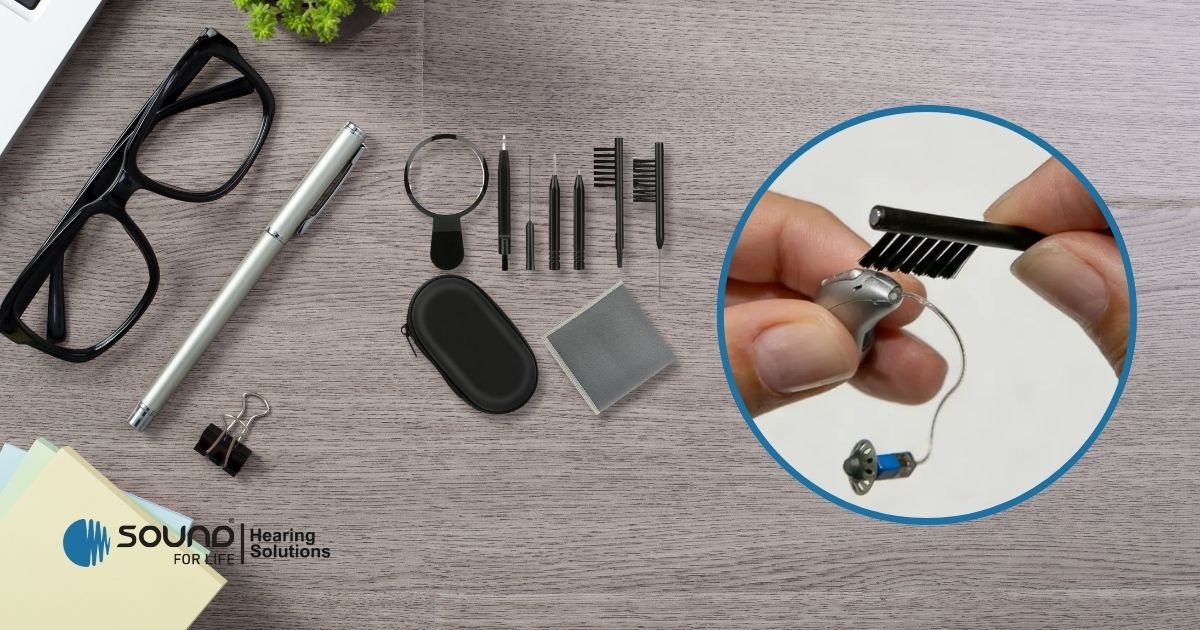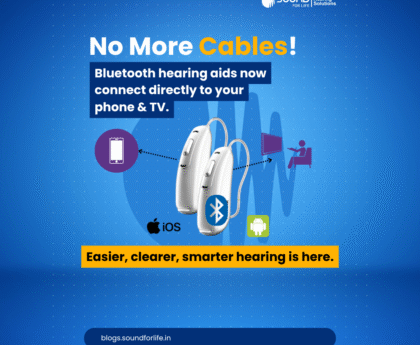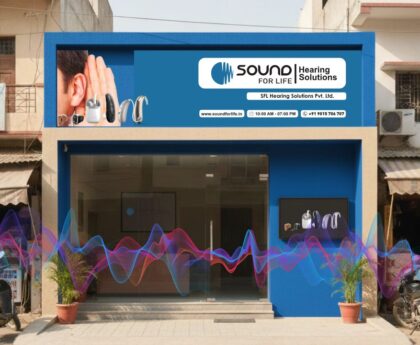Hearing aids can change people’s lives for the better, especially in a country like India where many people don’t get their hearing loss diagnosed or treated. Your hearing aids need to be taken care of properly so that they work well and last longer, whether you wear them all day or just sometimes. And what’s the most important part of that care?
The right way to clean your hearing aids at home.
This SFL Hearing Solutions guide will show you how to clean your hearing aids at home without hurting them. You can keep your device in great shape with just a few minutes of daily care. It’s easier than you think.
Why Cleaning Your Hearing Aids Matters?
Every day, hearing aids are exposed to dirt, sweat, oil, and dust from the environment, just like glasses, dentures, or your phone. Hearing aids, on the other hand, go inside your ear, which means they have to deal with earwax, which is an extra problem.
Here’s why regular cleaning is essential:
- Improves sound quality
- Prevents malfunctions and breakdowns
- Extends the life of the hearing aid
- Maintains hygiene and prevents ear infections
- Saves on repair or replacement costs
Ignoring cleaning can cause sounds to be muffled, feedback noises, or even the device to stop working completely. These problems can be easily avoided by following a few simple cleaning steps.
Before You Begin: Know Your Hearing Aid Type
There are different types of hearing aids, and each type may require a slightly different cleaning routine. Hearing aids are of mainly three styles, each designed for different needs and levels of visibility. Below is a simple guide to the three most common types.
1. Behind-the-Ear (BTE)
- This style has the microphone and amplifier housed in a small case that rests comfortably behind the outer ear. From that case sound passes through a clear plastic tube into a soft dome or earmold that is inserted into the ear canal. Those who are looking for dependable performance, larger batteries, or additional features like directional microphones and telecoils, BTE aids are an excellent option since they are sturdy and manageable.
2. Receiver-in-Canal (RIC)
- RIC aids look similar to BTE models but are slimmer and less noticeable. The main difference is that in RIC the receiver (speaker) is placed inside the ear canal while a thin wire connects it to the body of the device behind the ear. This setup delivers clearer sound with less occlusion (blocked-up feeling) and often feels lighter. RICs strike a balance between discreetness and power.
3. In-the-Ear (ITE) / In-the-Canal (ITC) / Completely-in-Canal (CIC)
- These hearing aids place all components inside the outer or inner ear. “In-the-Ear” (ITE) fits the outer ear, “In-the-Canal” (ITC) sits partly in the canal, and “Completely-in-Canal” (CIC) is tucked deep and is very discreet. Because they’re small and close to the eardrum, they look less visible and can sound natural, but their tiny size means smaller batteries and a higher chance of wax or moisture affecting performance. For those who prioritize appearance and subtlety, these hearing aids are perfect for them.
Choose the style that best fits daily activities, manual dexterity, cosmetic preference, and how much maintenance you’re comfortable with.
Check your hearing aid model before proceeding to clean.
What You’ll Need: Hearing Aid Cleaning Tools
You don’t need anything special to clean your hearing aids; most of them come with a simple kit. If not, you can easily find cleaning supplies online or at a hearing aid clinic.
Must-Have Tools:
- Soft, dry cloth or tissue
- Small brush (often provided with hearing aids)
- Vent cleaner / wax pick
- Multitool with magnetic battery remover
- Hearing aid blower (for BTE tubing)
- Drying box or dehumidifier (optional but recommended)
Never put soap, water, alcohol, or cleaning sprays directly on the hearing aid. These can hurt the electronics inside.
Daily Cleaning Routine (Takes 2-3 Minutes)
Step 1: Wash Your Hands
Make sure your hands are clean and dry before you touch your hearing aids. This keeps dirt and oil from getting on the device.
Step 2: Remove and Wipe
Gently remove the hearing aid from your ear and wipe it with a soft, dry cloth or tissue. Focus on removing:
- Moisture
- Dirt
- Sweat
Tip: Do this every night before bed.
Step 3: Brush Away Earwax
Using a small cleaning brush:
- Brush the microphone ports, receiver, and tubing ends.
- Always hold the hearing aid facing downward so debris falls out, not in.
For ITE or CIC models, earwax can block the sound outlet, so cleaning it daily is critical.
Step 4: Use a Wax Pick
Use the wax pick to carefully remove any blockage if your device has a wax guard or vent. “Handle gently; don’t push or insert deeply.”
Step 5: Clean the Earmold or Dome
If you wear BTE or RIC hearing aids:
- Detach the dome or earmold if it’s removable.
- Wipe with a cloth.
- Once a week, clean the earmold with warm water and let it dry overnight.
Never reattach a wet mold to the hearing aid! Moisture can damage the internal parts.
Weekly Deep Cleaning Tips
In addition to daily cleaning, follow these tips once a week:
For BTE Hearing Aids:
- Remove the earmold tubing.
- Use a hearing aid blower to remove moisture or debris from the tubing.
- Make sure it’s completely dry before you reassemble it.
For ITE or RIC Hearing Aids:
- Check the wax guard. If it’s dirty or blocked, replace it (usually once a month or as needed).
Use a drying box or hearing aid dehumidifier overnight. This removes moisture and prolongs lifespan, especially in India’s humid climate.
Common Mistakes to Avoid
Many people accidentally damage their hearing aids while cleaning. Here are some common mistakes that can be avoided by following the given steps:
- Avoid pouring or putting the devices in the water or rubbing it alcohol, moisture and strong solvents can ruin the electronics.
- Never use needles, pins, or other pointed things to prod vents or apertures since doing so might destroy delicate pieces or drive wax farther into.
- Hair dryers, space heaters, and other high-heat sources should not be used to hasten drying since they can deform plastics and harm internal components.
- Avoid skipping cleaning for weeks at a time; allowing dirt and wax to accumulate can cause long-term issues and decrease performance.
- Always remove the batteries before you clean the hearing aid to prevent short circuits or inadvertently turning on the device while you’re working on it.
- To prevent moisture damage, put your hearing aids in a dry case or dehumidifier rather than in wet areas like restrooms.
Special Care Tips for India’s Climate
India’s diverse climate can be tough on electronics, including hearing aids. Here’s how to protect your hearing aids:
During Humid Months:
- Run a hearing-aid dehumidifier every night to remove moisture and keep components dry.
- Store your devices in a cool, dry place, not in the bathroom or near sinks.
During dusty seasons
- Wipe and inspect your hearing aids every day; if dust is heavy, clean them twice daily.
- Keep a protective case with you when you go outside so your aids stay covered between uses.
During festivals (Holi, Diwali, etc.)
- Avoid wearing your hearing aids when you expect exposure to color powders, water splashes, smoke, or very loud music.
- If you must be in those environments, use protective covers or sleeves to shield the devices.
When Should You See a Professional?
While home cleaning helps maintain performance, your hearing aids still need professional servicing once in a while.
Visit a hearing care clinic like SFL Hearing Solutions if you notice:
- Distorted or weak sound
- Feedback (whistling sound)
- Blocked wax guards
- Battery not lasting long
- Water damage or visible cracks
We recommend a professional cleaning every 6 months, and annual hearing aid checkups for optimal hearing health.
Caring for Rechargeable Hearing Aids
Many modern hearing aids come with rechargeable batteries. These also require special care:
- Never use wet hands when charging.
- Clean the charger and hearing aids on a regular basis.
- Avoid overcharging and store the charger in a cool, dust-free place.
If the charging port or contacts are dirty, carefully brush them clean, do not use liquids or force anything.
Quick troubleshooting guide
1. No sound
- Likely cause: wax clog or blocked receiver.
- Fix: clean the receiver and replace the wax guard. If that doesn’t help, get the aid checked by a technician.
2. Weak or muffled sound
- Likely cause: moisture or debris inside the device.
- Fix: run the hearing aid in a dehumidifier or dry overnight, then inspect and clean openings.
3. Whistling / feedback
- Likely cause: wax in the ear or a poor-fitting mold/dome.
- Fix: clean your ear and check that the mold or dome fits snugly. Try a different size or contact your fitter if the sound keeps whistling.
4. Short battery life
- Likely cause: dirty battery contacts or an old battery.
- Fix: After cleaning the contacts and battery terminals, insert the battery back in. For rechargeable aids, ensure they charge fully and avoid leaving them on the charger continuously.
If any problem continues after these steps, contact your hearing-care professional, do not attempt to repair yourself.
What About Children’s Hearing Aids?
Parents can follow these simple steps to keep devices working well and comfortable:
- Clean the device every night before bed.
- Change wax guards more often than you would for an adult.
- Use a dehumidifier made for pediatric hearing aids overnight to remove moisture from sweat or humidity.
- At least once a week check the fit and listen for changes in performance.
- Schedule a professional cleaning and inspection every 3–4 months so a clinician can catch issues early and keep the aids tuned.
A few minutes of daily care keeps hearing aids long lasting, reliable and comfortable. You can save thousands of rupees on repairs or replacements by spending just a few minutes a day.
At SFL Hearing Solutions, we are here to support and assist you at every stage, from the right device to keeping it in good shape for years to come.
Ready to hear clearly every day?
If you’re not sure how to clean your hearing aid or would like a professional check, visit your nearest SFL Hearing Solutions centre or call us for a complimentary hearing-aid check-up. We stock care kits, dehumidifiers, and cleaning tools at locations across India. Let our expert audiologists help you look after your hearing with a trusted care that’s practical and affordable.





